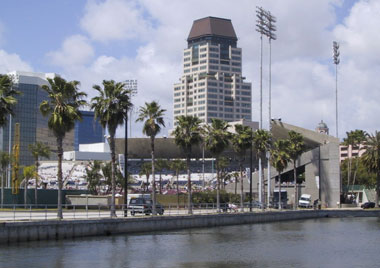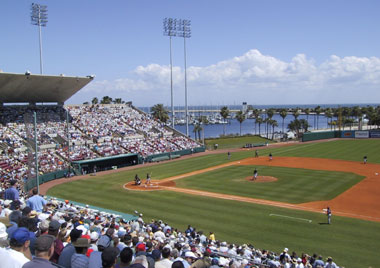
|
Taking in a Devil Rays game at St. Petersburg's Progress Energy Park is a Spring Training treat. You'd be hard pressed to find a spring facility with more postcard appeal.
Nowhere in Florida will you find a more spectacular setting for baseball. It's not that the stadium itself is memorable; it's the all-important aspect of location, location, and location. Florida Power Park (the ballpark's previous name) in its current state was rebuilt on the St. Pete waterfront in 1976, just a few feet away from where the bay ends and land begins. The view from the first base side of the field offers up one of the most breathtaking, camera-friendly shots in baseball, as blue water fades into the blue sky in a scenic shot framed by palm trees swaying in the bay breeze and sailboats docked at the marina located just off the left field line. While the Tampa Bay envelops the ballpark from one side, the other half is framed by downtown St. Petersburg, and some of the tallest buildings in the city loom on the horizon directly behind Florida Power Park. Not that a tall building here would amount to much in any other locale of its size, which is part of the charm of this city located just 15 miles south of Tampa. If that isn't enough, the small (100-acre) Albert Whitted Airport, which serves small private planes and charters, juts out into the waterfront, and the landing strip that seemingly chops the water in half serves as the take off point for a number of small aircraft during the game. If you see an airplane with an advertising banner flying overhead, you know where it came from and where it will land. Although the airport has been a St. Pete waterfront mainstay since it opened in 1929, it was actually preceded by the ballpark in 1922, originally named the St. Petersburg Athletic Park. The Boston Braves trained here when the park opened through 1937, and a marker in the shape of home plate stands just north of the stadium detailing that fact. The St. Louis Cardinals moved in after the Braves left, and with the exception of the WW2 years of 1943-45, the Redbirds trained in St. Pete through the 1997 season. During the Cardinals tenure here the city rebuilt the ballpark and christened it Al Lang Field in 1947. With such beautiful surroundings to take in, the game itself is almost secondary. Often, the action on the field interjects itself with the scenery located just beyond the park's boundaries. It's a common occurrence for a foul ball to land in the bay on the fly, or bounce once off the road and splash land into the water. The stadium's seating is the traditional first base to third base grandstand bowl that is the common configuration of Spring Training stadiums. The grandstand roof only offers shade to a handful of the upper tier seats behind home plate and the dugouts, so you are almost guaranteed to be in the sun unless you're sitting in the press box. Unfortunately, the ballpark isn't as fan-friendly as it once was. For starters, Florida Power Park has the distinction of being the only Spring Training facility to bear the name of a corporate sponsor. When the Cardinals moved out to accommodate the hometown Devil Rays, Florida Power decided to buy the naming rights of the stadium for $150,000 a year. And so Al Lang Stadium became Florida Power Park at Al Lang Field, which is not as bad when Miami's Joe Robbie Stadium became Pro Player Park, but it still follows that disturbing trend. Fortunately, no other team or municipality has followed suit with what could have become a naming rights bonanza for spring stadiums. Since I last visited in 1997 berm seating has been added down the right field line, which is a plus. But a berm section was also placed down the left field line and from a fans point of view this addition took away one of the coolest quirks of the park. In the past you didn't need to gain admittance to the ballpark to watch the action, as a chain link fence was all that obstructed your view of the diamond from the street that runs parallel to the bay. Before the hill that was used to construct the left field berm existed, you could stand directly behind the visiting team's bullpen, so close that you could hear the conversations between the pitchers. This was the best of the knothole world, baseball's version of a gaping hole in the girls' locker room. For free of charge you could watch the game and get autographs from the players sitting just a foot or two away. Another addition to the park that came as a result of the Devil Rays affiliation was the addition of a rotunda, which is used as one of the two main entrances to the park and was modeled after the signature feature of the team's Major League stadium. Unlike the ground level entrance of Tropicana Field's rotunda, the Florida Power Park version requires you to ascend a number of stairs, which backs up the crowd immediately after the game. Despite being the only team to play their spring games in their home city the Devil Rays don't draw much of a crowd, which isn't just a problem for the team in March. The Rays' regular season home is the domed Tropicana Field, which is located just 12 blocks away. The biggest complaint I hear about the frequently empty, canavernos "Trop" is that it is an indoor facility. With the crowds the Devil Rays average for most regular season contests, it might make sense to move a few games over to Florida Power Park. It's not the first time this sarcastic remark was been made. Under the generous "ticket sold" feature that is used to compute attendance, the Rays frequently drew crowds of 10,000-11,000, while averaging only 16,026 in a 45,200-seat stadium. Factor in a large number of no-shows and you wouldn't have to exactly shoehorn the remaining fans into the 7,227-seat Florida Power Park. I do have to give kudos to another important aspect that contributes to the ballpark atmosphere that is lacking at virtually all Spring Training stadiums. Just outside of Florida Power Park is a portable cart hot dog stand, where for $3 I had two chili dogs, a bag of chips, and a Coke. I really enjoy being able to eat on the cheap outside of the ballpark while mingling with other fans, a feature I'm not used to at Braves games in Atlanta (my hometown), but came accustomed to after visiting Jacobs Field, Camden Yards, and Yankee Stadium in the summer of 2001. Oddly enough, the Devil Rays won't let hot dog vendors do their thing around Tropicana Field during the regular season, so the only time to fill up on good, cheap ballpark grub prior to watching bad, cheap payroll baseball is during the spring. If you are interested in catching a game at Florida Power Park be aware that the stadium is dormant outside of Spring Training. The Devil Rays had a Class A Florida State League team, dubbed the "Baby Rays," stationed here through the 2000 season, but packed up that operation and sent it as far away as possible: 2,662 miles to the west and Bakersfield, California. So why is the stadium with the gorgeous backdrop deprived of a permanent tenant? The Devil Rays sold the St. Petersburg franchise back to Minor League Baseball to facilitate a realignment scheme that ensured each major-league club would have a farm team at each minor-league level. In other words, in an effort to balance the number of high Class A and low Class A teams so that each Major League team will have one of each, Minor League Baseball dropped two Florida State League teams (St. Petersburg and Kissimmee) and added two South Atlantic League teams. As part of the process the Devil Rays were asked to sell the team back to Minor League Baseball, which in a bizarre twist of irony, has its headquarters in St. Petersburg next door to Florida Power Park. Asked about the situation, St. Petersburg Mayor David Fisher had this to say: "I think the surprise is really that they've stayed here this long. It's a challenge to attract people to a minor-league team in a major-league city." Apparently it's just as hard to attract them to a major league team in a long-time minor league city. But I think what sums up the situation best was echoed in the St. Petersburg Times on August 27, 2000: "Al Lang Field, sitting on the edge of Tampa Bay, is the best place on earth to watch a baseball game." In other words, it's definitely worth the trip.
Parking$3-4 at nearby parking lots, including the St. Petersburg campus of the University of South Florida, located directly behind right field. Nearby garage parking is available for $5 if you arrive early enough. Or you can avoid paying and park for free at the city-owned Demens Landing, named after the Russian immigrant who co-founded this city and was responsible for the name St. Petersburg, honoring his Russian hometown. Demens Landing is located at the marina, a short walk from the stadium. Most of the spaces are reserved for boat owners, but the back lot is open to the public and there are always empty spaces.
St. Petersburg - Stadium & City Footnotes
| ||||||||||||||||||||||||||



